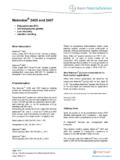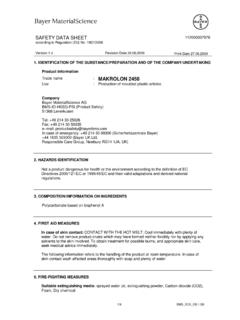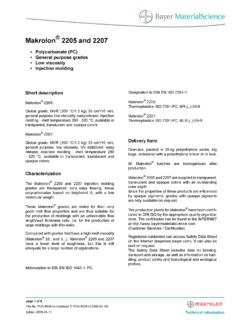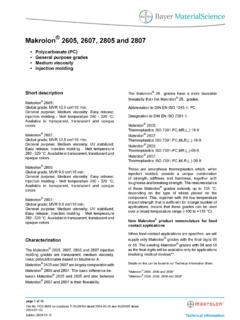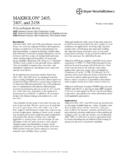Transcription of Makrolon 2458 - lidorr.com
1 Page 1 of 8 File No. PCS-8071 en (replaces TI KU28025 dated 2004-06-16)Edition 2008-03-19 Technical InformationMakrolon 2458 Polycarbonate (PC) Low viscosity Injection molding Medical devices**Short descriptionGlobal grade; MVR 19 cm /10 min; Medical devices;suitable for ETO and steam sterilization at 121 C;Complies with the requirements of FDA-modifiedISO 10993-1 and USP Class VI; Low viscosity;Easy release; Good hydrolysis resistance; Injectionmolding - Melt temperature 280 - 320 C; Available intransparent and opaque colorsCharacterizationMakrolon 2458 is a transparent, easy flowing, linearpolycarbonate based on bisphenol A, with goodhydrolysis is used for applications in medical technology**, inparticular for sterilizing medical equipment with super-heated steam at a temperature of 121 C or withethylene adhesives and solvents normally used for medi-cal applications of polycarbonate can also be employ-ed to produce a reliable bond between componentsmade of Makrolon 2458 and plasticized 2458 was tested according to the FDA-modified ISO 10993-1 and USP Class VI tests, andmeets the requirements specified for up to 30 dayscontact with human Makrolon grade is noted for its very good meltflow properties and is thus suitable for the productionof moldings with an unfavorable flow length/wall thick-ness ratio.
2 Compared with grades that have a highmelt viscosity ( Makrolon and ), Makrolon 2458 has a lower level of toughness, but this is stillperfectly adequate for a large number of to DIN EN ISO 1043-1: PCDesignation to DIN EN ISO 7391-1:Thermoplastics ISO 7391-PC,MR,(,,)-18-9 Delivery formGranules, packed in 25-kg polyethylene sacks, FIBC(flexible intermediate bulk containers big bags),large cartons with a polyethylene inliner or in Makrolon batches are homogenized 2458 is supplied in transparent andopaque 2458 is only available in colors in whichthe pigments comply with the requirements specifiedin the FDA-modified ISO 10993-1 and USP Class VItests for up to 30 days contact with human production plants for Makrolon have been certifi-cated to DIN ISO by the appropriate quality organiza-tions. The certificates can be found in the INTERNETat (Customer Services / Certificates).
3 Registered customers can access Safety Data Sheeton the Internet ( ). It can also besent on Safety Data Sheet includes data on labeling,transport and storage, as well as information on han-dling, product safety and toxicological and 2 of 8 File No. PCS-8071 en (replaces TI KU28025 dated 2004-06-16)Edition 2008-03-19 Technical InformationApplicationsMakrolon 2458 is a product intended for applicationsin medical technology**.It can be used for the production of inhalers, cardio-metry reservoirs and oxygenators, for particular requirements are placed on tough-ness, higher-viscosity grades should be preferred.** See DisclaimerProperties (see also table)In terms of its flow behavior, processability and me-chanical, thermal and electric properties, Makrolon 2458 is comparable to the general purpose grade1) Makrolon ) Details on this can be found in our Technical Information Sheet." Makrolon 2405 and 2407"BiocompatibilityAll Bayer resins, films, etc.
4 (hereinafter "Products")designated as "medical-grade" have met the require-ments of the FDA-Modified ISO 10993, Part 1 "Biolog-ical Evaluation of Medical Devices" tests with humantissue contact time of 30 days or less. These testsare conducted under Good Laboratory Practices asdefined by the FDA in 21 CFR Part 58. The productswere sterilized by ethylene oxide and gamma radia-tion prior to testing. Only these Products may be con-sidered candidates for applications requiring biocom-patibility. No "medical-grade" Product will be availablefor sale until successful completion of resins must not be used in medical applica-tions requiring ISO 10993, Part 1 "Biological Evalua-tion of Medical Devices" tests with human tissue con-tact time of 30 days or less have largely supplantedolder USP Plastics Class VI and other standards tests include:- Acute system toxicity- Intracutaneous toxicity- Muscle implantation- Cytotoxicity - (MEM Elution)- Hemolysis - direct and extraction- Physicochemical tests- Heavy metal analysis- Pyrogen study- Sensitization (maximization method)- saline extract, oil extract- Mutagenicity, Ames test- saline extract, and 95 % ethanol extractTest data will be mailed on and SterilizationMolded parts made of Makrolon 2458 can be disin-fected and sterilized with ethylene oxide gas or super-heated steam at 121 C using most of the methodsemployed today in practice.
5 Under certain conditions,however, contact with disinfectants can cause dam-age to the molded parts. Critical factors here are thechemical constituents and their concentration in thedisinfectants, the state of internal stress of the moldedparts, the mechanical loading and the temperatureduring )Depending on their composition, disinfectants cancause damage to parts molded from Makrolon 2458 . A degree of caution is necessary with certainproducts containing aldehydes, phenols or aminesas active ingredients. That apart, studies show thatMakrolon is compatible with a broad range ofstandard commercial ) Makrolon 2458 can be sterilized with ethylene oxidegas or with superheated steam at a temperature of121 C using conventional techniques. The use of var-ious methods of sterilization and the permittednumber of sterilization cycles for multiple-use medicalarticles made from our materials depend on thedesign of the parts, the processing parameters,the sterilization temperature and the chemicalenvironment.
6 The manufacturer must thereforedetermine and evaluate the most suitable method ofpage 3 of 8 File No. PCS-8071 en (replaces TI KU28025 dated 2004-06-16)Edition 2008-03-19 Technical Informationsterilization (and if applicable the permitted numberof sterilization cycles) for each medical instructions and warnings must be givento the end user. Medical products intended for singleuse that are manufactured using a Bayer plastic areunsuitable for multiple ) Details on this can be found in our Technical Information Sheet."Plastics for medical devices""Cleaning, Disinfection and Sterilisation of Parts in Makrolon ""The chemical resistance of Makrolon "ProcessingPre-treatment / drying3) Makrolon must be dried prior to processing. Forinjection molding no more than % residualmoisture may be present in the granules and, forextrusion, no more than %. Moisture in themelt leads to surface defects as well as to a greaterreduction in molecular should be dried in suitable dryers at120 drying time for moist granules is largely a functionof the nature and type of the drying unit and cantotal 2 to 12 hours depending on the drying times of 2 to 4 hours are sufficient in modernhigh-speed dryers.
7 One means of dispensing withpre-drying is for the moisture to be removed duringmelting with the aid of a degassing unit, as has beenstandard practice in extrusion for a long molding3) Makrolon can be processed on all modern injectionmolding machines. Shut-off nozzles are suitable givensufficient, uniform heating. At high melt temperatures,melt can flow out of open nozzles. Molding shrinkageis more or less identical in all directions and amountsto between and % for Makrolon melt temperatures generally employed duringprocessing are between 280 and 320 damage has to be expected with excessivelyhigh processing temperatures or excessively longresidence times in the cylinder and hot runner. Thiscan lead to a reduction in toughness and/or to surfacedefects in the form of should be possible for the molds to be heatedintensively and uniformly, and the mold temperatureshould be at least 80 C to ensure parts with a lowinherent stress and a good surface.
8 No demoldingdifficulties are encountered at up to 120 C. It willnot generally be necessary to employ mold releaseagents when Makrolon grades with easy moldrelease are the recommended processing conditions, smallquantities of decomposition product may be given offduring processing. To preclude any risk to the healthand well-being of the machine operatives, tolerancelimits for the work environment must be ensured bythe provision of efficient exhaust ventilation and freshair at the workplace in accordance with the SafetyData order to prevent the partial decomposition of thepolymer and the generation of volatile decompositionproducts, the prescribed processing temperaturesshould not be substantially ) Details on this can be found in our TechnicalInformation Sheet."Determining the dryness of Makrolon by the TVItest""Processing data for the injection molder""The Injection Molding of High-Quality Molded Parts"page 4 of 8 File No.
9 PCS-8071 en (replaces TI KU28025 dated 2004-06-16)Edition 2008-03-19 Technical InformationViscosity in Pa s260 C280 C300 C320 C1E11E21E31E41E51E11E21E31E4 Fig. 1: Melt viscosity as a function of shear rate ( Makrolon 2458 )Stress in MPa-40 C-20 C0 C23 C40 C60 C90 C120 C0246810020406080100 Fig. 2: Isothermal stress-strain curves from the short-time tensile test to ISO 527-1, -2 ( Makrolon 2458 )page 5 of 8 File No. PCS-8071 en (replaces TI KU28025 dated 2004-06-16)Edition 2008-03-19 Technical InformationShear Modulus G'Shear Loss Modulus G''Shear Loss Factor Tan DeltaG'G''tan d-60-1040901401901E01E11E21E31E41E-31E-2 1E-11E01E1 Fig. 3: Shear modulus as a function of temperature to ISO 6721-1, -2 ( Makrolon 2458 )page 6 of 8 File No. PCS-8071 en (replaces TI KU28025 dated 2004-06-16)Edition 2008-03-19 Technical InformationTypical ValuesPropertyTest ConditionUnitStandardMakrolon 2458 Rheological propertiesCMelt volume-flow rate300 C; kgcm /10 minISO 113319 CMolding shrinkage, parallel60x60x2; 500 bar%ISO shrinkage, normal60x60x2; 500 bar%ISO shrinkage, parallel/normalValue range based on generalpractical experience% ISO - mass-flow rate300 C; kgg/10 minISO 113320 Mechanical properties (23 C/50 % r.)
10 H.)CTensile modulus1 mm/minMPaISO 527-1,-22400 CYield stress50 mm/minMPaISO 527-1,-265 CYield strain50 mm/min%ISO 527-1, strain at break50 mm/min%ISO 527-1,-2> 50 Stress at break50 mm/minMPaISO 527-1,-265 Strain at break50 mm/min% ISO 527-1,-2120 CTensile creep modulus1 hMPaISO 899-12200 CTensile creep modulus1000 hMPaISO 899-11900 Flexural modulus2 mm/minMPaISO 1782350 Flexural strength2 mm/minMPaISO 17897 Flexural strain at flexural strength2 mm/min%ISO stress at % strain2 mm/minMPaISO 17873 CCharpy impact strength23 CkJ/m ISO 179/1eUNCC harpy impact strength-30 CkJ/m ISO 179/1eUNCharpy impact strength-60 CkJ/m ISO 179/1eUNCharpy notched impact strength23 C; 3 mmkJ/m ISO 179/1eA65 PCharpy notched impact strength-30 C; 3 mmkJ/m ISO 179/1eA14 CIzod notched impact strength23 C; mmkJ/m ISO 180/A75P(C)Izod notched impact strength-30 C; mmkJ/m ISO 180/A12 CCPuncture maximum force23 CNISO 6603-25100 CPuncture maximum force-30 CNISO 6603-26000 CPuncture energy23 CJISO 6603-255 CPuncture energy-30 CJISO 6603-265 Ball indentation hardnessN/mm ISO 2039-1115page 7 of 8 File No.
